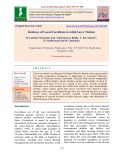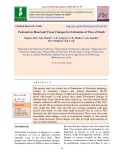
Postmortem blood
-
Caecal coccidiosis was diagnosed in Rajasri birds of nineteen weeks age presented for routine postmortem examination at Department of Veterinary Pathology, College of Veterinary Science, Hyderabad. Clinically birds showed inappetence, depression, ruffled feathers, bloody diarrhea, anemia and mortality of about 21 birds out of 65 birds (32.3%) for a period of two weeks. Grossly, extremely ballooned caeca, white necrotic foci visible from outside of caeca, haemorrhagic enteritis, watery ingesta mixed with mucus and blood were observed.
 4p
4p  caygaocaolon3
caygaocaolon3
 27-02-2020
27-02-2020
 10
10
 0
0
 Download
Download
-
The present work was carried out in Department of Veterinary pathology, College of Veterinary Science and Animal Husbandry, OUAT, Bhubaneswar to study changes of different blood parameters in postmortem blood with respect to time passed since death. Postmortem changes of different body tissues like liver, heart, kidney etc. were also studied. Blood samples collected in EDTA vial were analysed for estimation of Hb, TEC, TLC and pH. Hb in postmortem blood had no correlation with time passed since death. But TEC, TLC and pH were strongly correlated with time passed since death.
 11p
11p  caygaocaolon3
caygaocaolon3
 27-02-2020
27-02-2020
 19
19
 0
0
 Download
Download
-
Introduction: Pentazocine ( Fig. 5.1) is a non-narcotic analgesic, but shows mild dependence; there are many cases of pentazocine abuse especially for medical and co-medical workers. The drug is being regulated as a subclass compound of narcotics (DEA class: IV). Pentazocine in both antemortem and postmortem specimens is being analyzed by GC [1–4], HPLC [5–7] and GC/MS [8]. In this chapter, a simple method for GC/MS analysis of pentazocine in human whole blood and urine is presented. ⊡ Figure 5.1 Structures of pentazocine and dextromethorphan (IS). Reagents and their preparation i.
 5p
5p  bigbaby87
bigbaby87
 01-09-2010
01-09-2010
 146
146
 19
19
 Download
Download
-
Introduction: Blood and urine are the common specimens for drug analysis in both antemortem and postmortem cases. Usually, urine is used for drug screening using immunoassays at the first step; secondly, the drug detected is chromatographically quantitated with blood. The data obtained are carefully assessed with taking the values reported in references into consideration together with clinical and postmortem findings; the judgement of poisoning and its degree is made comprehensively.
 8p
8p  bigbaby87
bigbaby87
 01-09-2010
01-09-2010
 97
97
 10
10
 Download
Download
CHỦ ĐỀ BẠN MUỐN TÌM

















